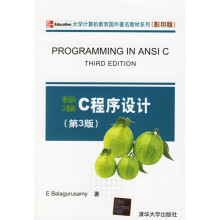大学计算机教育国外著名教材系列:标准C程序设计(第3版)(影印版)

目 录内容简介
1. Overview of C 11.1 History of C 11.2 Importance of C 21.3 Sample Program 1: Printing a Message 31.4 Sample Program 2: Adding Two Numbers 61.5 Sample Program 3: Interest Calculation 71.6 Sample Program 4: Use of Subroutines 91.7 Sample Program 5: Use of Math Functions 101.8 Basic Structure of C Programs 121.9 Programming Style 131.10 Executing a ‘C’ Program 141.11 Unix System 141.12 MS-DOS System 17Review Questions 18Programming Exercises 202. Constants, Variables, and Data Types 222.1 Introduction 222.2 Character Set 222.3 C Tokens 242.4 Keywords and Identifiers 242.5 Constants 252.6 Variables 292.7 Data Types 302.8 Declaration of Variables 332.9 Declaration of Storage Class 362.10 Assigning Values to Variables 382.11 Defining Symbolic Constants 432.12 Declaring a Variable as Constant 442.13 Declaring a Variable as Volatile 452.14 Overflow and Underflow of Data 45Case Studies 46Review Questions 48Programming Exercises 503. Operators and Expressions 513.1 Introduction 513.2 Arithmetic Operators 513.3 Relational Operators 543.4 Logical Operators 553.5 Assignment Operators 563.6 Increment and Decrement Operators 583.7 Conditional Operator 593.8 Bitwise Operators 603.9 Special Operators 603.10 Arithmetic Expressions 623.11 Evaluation of Expressions 623.12 Precedence of Arithmetic Operators 643.13 Some Computational Problems 663.14 Type Conversions in Expressions 673.15 Operator Precedence and Associativity 703.16 Mathematical Functions 72 Case Studies 73 Review Questions 76 Programming Exercises 784. Managing Input and Output Operations 804.1 Introduction 804.2 Reading a Character 814.3 Writing a Character 844.4 Formatted Input 854.5 Formatted Output 94 Case Studies 103 Review Questions 106 Programming Exercises 1085. Decision Making and Branching 1105.1 Introduction 1105.2 Decision Making with if Statement 1105.3 Simple if Statement 1115.4 The if.....else Statement 1155.5 Nesting of if....else Statements 1185.6 The Else if Ladder 1225.7 The Switch Statement 1255.8 The ? : Operator 1295.9 The Goto Statement 132 Case Studies 135 Review Questions 139 Programming Exercises 1426. Decision Making and Looping 1456.1 Introduction 1456.2 The While Statement 1476.3 The do Statement 1506.4 The for Statement 1526.5 Jumps in Loops 159 Case Studies 168 Review Questions 174 Programming Exercises 1777. Arrays 1807.1 Introduction 1807.2 One-dimensional Arrays 1827.3 Declaration of One-dimensional Arrays 1837.4 Initialization of One-dimensional Arrays 1857.5 Two-dimensional Arrays 1897.6 Initializing Two-dimensional Arrays 1937.7 Multi-dimensional Arrays 1977.8 Dynamic Arrays 1987.9 More About Arrays 199 Case Studies 200 Review Questions 212 Programming Exercises 2148. Character Arrays and Strings 2178.1 Introduction 2178.2 Declaring and Initializing String Variables 2188.3 Reading Strings From Terminal 2198.4 Writing Strings to Screen 2248.5 Arithmetic Operations on Characters 2288.6 Putting Strings Together 2308.7 Comparison of Two Strings 2318.8 String-handling Functions 2328.9 Table of Strings 2378.10 Other Features of Strings 239 Case Studies 240 Review Questions 243 Programming Exercises 2459. User-defined Functions 2479.1 Introduction 2479.2 Need for User-defined Functions 2479.3 A Multi-function Program 2489.4 Elements of User-defined Functions 2519.5 Definition of Functions 2529.6 Return Values and their Types 2549.7 Function Calls 2559.8 Function Declaration 2579.9 Category of Functions 2599.10 No Arguments and No Return Values 2599.11 Arguments but No Return Values 2619.12 Arguments with Return Values 2659.13 No Arguments but Returns a Value 2699.14 Functions that Return Multiple Values 2699.15 Nesting of Functions 2719.16 Recursion 2729.17 Passing Arrays to Functions 2739.18 Passing Strings to Functions 2789.19 The Scope, Visibility and Lifetime of Variables 2799.20 Multifile Programs 289 Case Study 292 Review Questions 295 Programming Exercises 29910. Structures and Unions 30110.1 Introduction 30110.2 Defining a Structure 30110.3 Declaring Structure Variables 30310.4 Accessing Structure Members 30410.5 Structure Initialization 30610.6 Copying and Comparing Structure Variables 30710.7 Operations on Individual Members 30910.8 Arrays of Structures 31010.9 Arrays within Structures 31310.10 Structures within Structures 31410.11 Structures and Functions 31610.12 Unions 31910.13 Size of Structures 32010.14 Bit Fields 321 Case Study 324 Review Questions 328 Programming Exercises 33111. Pointers 33311.1 Introduction 33311.2 Understanding Pointers 33411.3 Accessing the Address of a Variable 33611.4 Declaring Pointer Variables 33711.5 Initialization of Pointer Variables 33811.6 Accessing a Variable through its Pointer 34011.7 Chain of Pointers 34211.8 Pointer Expressions 34311.9 Pointer Increments and Scale Factor 34411.10 Pointers and Arrays 34511.11 Pointers and Character Strings 34911.12 Array of Pointers 35111.13 Pointers as Function Arguments 35211.14 Functions Returning Pointers 35511.15 Pointers to Functions 35511.16 Pointers and Structures 358 Case Studies 362 Review Questions 367 Programming Exercises 36812. File Management in C 37012.1 Introduction 37012.2 Defining and Opening a File 37112.3 Closing a File 37212.4 Input/Output Operations on Files 37312.5 Error Handling During I/O Operations 37912.6 Random Access to Files 38112.7 Command Line Arguments 386 Review Questions 389 Programming Exercises 39013. Dynamic Memory Allocation and Linked Lists 39113.1 Introduction 39113.2 Dynamic Memory Allocation 39113.3 Allocating a Block of Memory: Malloc 39213.4 Allocating Multiple Blocks of Memory: Calloc 39413.5 Releasing the Used Space: Free 39513.6 Altering the Size of a Block: Realloc 39613.7 Concepts of Linked Lists 39713.8 Advantages of Linked Lists 40013.9 Types of Linked Lists 40113.10 Pointers Revisited 40213.11 Creating a Linked List 40413.12 Inserting an Item 40713.13 Deleting an Item 41013.14 Application of Linked Lists 412 Case Studies 413 Review Questions 420 Programming Exercises 42114. The Preprocessor 42314.1 Introduction 42314.2 Macro Substitution 42414.3 File Inclusion 42814.4 Compiler Control Directives 42914.5 ANSI Additions 432 Review Questions 435 Programming Exercises 43615. Developing a C Program: Some Guidelines 43715.1 Introduction 43715.2 Program Design 43715.3 Program Coding 43915.4 Common Programming Errors 44115.5 Program Testing and Debugging 44815.6 Program Efficiency 451 Review Questions 451Appendix I: Bit-level Programming 453Appendix II: ASCII Values of Characters 459Appendix III: ANSI C Library Functions 460Appendix IV: A Phone Book 464Bibliography 485Index 486
目 录内容简介
本书旨在教授读者如何使用C语言进行程序设计。全书贯彻了“用示例学习”的概念。在深入介绍了C语言的每个特性之后,给出了一个完整的示例程序,用于演示说明其应用。每章末尾的“案例学习”不仅介绍了把C语言的特性集成在一起的常用方法,而且还显示了它在实际生活中的应用。最后一章介绍了开发高效、无错误的C程序的一些指导原则。
本书第3版融入了过去10年中采用本书的学生和老师的很多反馈意见。
总之,本书的语言简洁易懂,示例非常丰富且具有很强的实际指导意义,是一本很好的C语言程序设计的教材。
本书第3版融入了过去10年中采用本书的学生和老师的很多反馈意见。
总之,本书的语言简洁易懂,示例非常丰富且具有很强的实际指导意义,是一本很好的C语言程序设计的教材。
比价列表
公众号、微信群
 缺书网
缺书网微信公众号
 扫码进群
扫码进群实时获取购书优惠






